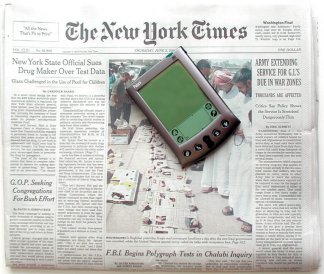A newspaper’s hidden cost
Getting a newspaper electronically would be much better for the planet than receiving the paper version.
By Emily Sohn
It’s a morning ritual for millions of people: Wake up. Have breakfast. Read the paper.
This simple, groggy habit is taking its toll on the environment, say researchers from the University of California, Berkeley. In a recent study, they found that reading the news on a handheld computer would be much better for the planet than reading the paper version.
 |
|
Getting a newspaper via a personal digital assistant (PDA) releases less carbon dioxide and other pollutants that are produced by printing and delivering the paper version.
|
| S. Norcross |
For their study, the researchers focused on the New York Times, which has more subscribers per 7-day week than any other newspaper in the United States. About 1.2 million subscribers get it on weekdays, and 1.7 million get the Sunday edition.
Producing the paper uses up a lot of energy and resources, the researchers found. One year’s worth of the New York Times weighs about 236 kilograms. It takes about 22,700 liters of water each year to make the paper for just one reader. The same processes release about 660 kilograms of carbon dioxide, a gas that contributes to global warming. Printing and transporting the newspaper release even more.
The researchers found that, just by trying to stay informed, a single daily reader in Berkeley contributes 270 kilograms of extra carbon dioxide to the atmosphere every year.
The New York Times also happens to be available in electronic form. People can download it through a wireless signal onto a portable little computer called a personal digital assistant (PDA), for example.
The researchers added up all of the energy that it takes to make a PDA and its batteries, recharge the batteries, and download the New York Times. They found that an individual reader using a PDA would be responsible for producing just 5 kilograms of carbon dioxide.
Clearly, it would be far more efficient if everyone took PDAs to the breakfast table instead of newspapers.
The hard part will be convincing people to get cozy with computers, when the act of turning pages or scanning the comics can be so enjoyable. And, even though it’s okay to spill cereal on the paper, a splash of juice on the PDA could be disastrous!
Going Deeper:
Perkins, Sid. 2004. Newspaper’s footprint: Environmental toll of all the news that’s fit to print. Science News 165(June 12):374. Available at http://www.sciencenews.org/articles/20040612/fob7.asp .







